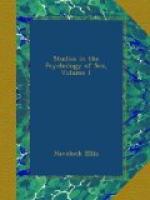Plato, it is true, cannot be said to reveal anywhere a very scientific attitude toward Nature. Yet he was here probably only giving expression to the current medical doctrine of his day. We find precisely the same doctrine attributed to Hippocrates, though without a clear distinction between hysteria and epilepsy.[254] If we turn to the best Roman physicians we find again that Aretaeus, “the Esquirol of antiquity,” has set forth the same view, adding to his description of the movements of the womb in hysteria: “It delights, also, in fragrant smells, and advances toward them; and it has an aversion to foetid smells, and flies from them; and, on the whole, the womb is like an animal within an animal."[255] Consequently, the treatment was by applying foetid smells to the nose and rubbing fragrant ointments around the sexual parts.[256]
The Arab physicians, who carried on the traditions of Greek medicine, appear to have said nothing new about hysteria, and possibly had little knowledge of it. In Christian mediaeval Europe, also, nothing new was added to the theory of hysteria; it was, indeed, less known medically than it had ever been, and, in part it may be as a result of this ignorance, in part as a result of general wretchedness (the hysterical phenomena of witchcraft reaching their height, Michelet points out, in the fourteenth century, which was a period of special misery for the poor), it flourished more vigorously. Not alone have we the records of nervous epidemics, but illuminated manuscripts, ivories, miniatures, bas-reliefs, frescoes, and engravings furnish the most vivid iconographic evidence of the prevalence of hysteria in its most violent forms during the Middle Ages. Much of this evidence is brought to the service of science in the fascinating works of Dr. P. Richer, one of Charcot’s pupils.[257]
In the seventeenth century Ambroise Pare was still talking, like Hippocrates, about “suffocation of the womb”; Forestus was still, like Aretaeus, applying friction to the vulva; Fernel was still reproaching Galen, who had denied that the movements of the womb produced hysteria.
It was in the seventeenth century (1618) that a French physician, Charles Lepois (Carolus Piso), physician to Henry II, trusting, as he said, to experience and reason, overthrew at one stroke the doctrine of hysteria that had ruled almost unquestioned for two thousand years, and showed that the malady occurred at all ages and in both sexes, that its seat was not in the womb, but in the brain, and that it must be considered a nervous disease.[258] So revolutionary a doctrine could not fail to meet with violent opposition, but it was confirmed by Willis, and in 1681, we owe to the genius of Sydenham a picture of hysteria which for lucidity, precision, and comprehensiveness has only been excelled in our own times.




